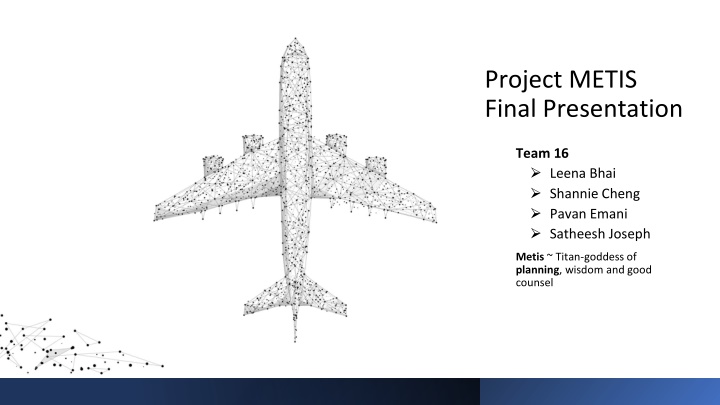
Flight Delay Prediction with Ensemble Model and Feature Engineering
"Explore how Team 16 leveraged feature engineering and ensemble modeling to predict flight delays, tackling an imbalanced classification problem. Dive into their business case, EDA insights, ML pipeline stats, and next steps in this comprehensive project presentation."
Download Presentation

Please find below an Image/Link to download the presentation.
The content on the website is provided AS IS for your information and personal use only. It may not be sold, licensed, or shared on other websites without obtaining consent from the author. If you encounter any issues during the download, it is possible that the publisher has removed the file from their server.
You are allowed to download the files provided on this website for personal or commercial use, subject to the condition that they are used lawfully. All files are the property of their respective owners.
The content on the website is provided AS IS for your information and personal use only. It may not be sold, licensed, or shared on other websites without obtaining consent from the author.
E N D
Presentation Transcript
Project METIS Final Presentation Team 16 Leena Bhai Shannie Cheng Pavan Emani Satheesh Joseph Metis ~ Titan-goddess of planning, wisdom and good counsel
Agenda Business Case EDA Feature Engineering Performance Models Novelty Next Steps
Business Case Issue: Flight delays are 33B addressable problem Goal: To predict a flight delay two hours before the departure time. Problem: An imbalanced classification problem, with one class representing the overwhelming majority of the data points. Metrics: Outcome: An ensemble model with Majority Voting approach.
EDA Airlines: `DEP_DEL15` has 4935 (1.6%) missing values. `OP_CARRIER` is highly correlated with ORIGIN_STATE_NM. `DISTANCE_GROUP` is highly correlated with ORIGIN_STATE_NM. `CANCELLED` has 312915 (98.4%) zeros. `ORIGIN` has a high cardinality: 366 distinct values. `DEST` has a high cardinality: 365 distinct values.
EDA Weather: Date Range for weather data is 01/01/2015 to 12/31/2019. WND, CIG, VIZ, TMP, DEW and SLP are composite features with comma seperated values Eg. 999,9,C,0000,5 ; 22000,5,9,N ; +9999,9 ; +9999,9; 10151,1 respectively. <br> Missing values are coded in 9s. Tool tips: - - Databricks data profile can be used for quick data analysis. Pandas profiling generates an interactive profile report for selected features.
Feature Engineering Characteristics of airline & airport Is_base_airport_origin is_base_airport_destination is_regional_airline Seasonality Is_weekend is_holiday
Time Based Features Flights_delayed one hour before the prediction time on a given airport Find the total number of flights that are delayed in an airport in each DEP_TIME_BLK. Self-join the airlines table with a time block which is three hours before the airline s time block. Join on flight date, airport_id, and on two different DEP_TIME_BLK
ML Pipeline Execution Stats Cluster Capacity: Total Compute: 28 vCPUs Total Memory: 112 GB Total Executors: 24 Process Time Taken EDA 15 min Feature Engineering 10 min Joins 12 min Model Training 30 min Model Predictions 2 min
Join Optimization Issue Mitigation Data Quality issues in IATA codes in Stations dataset - Used an IATA lookup file from datahub.io Join between Airlines and Stations data was slower - Improved join performance by only getting stations for unique airports in Airlines dataset. Ranked stations by distance_to_neighbor - Join between Airlines and Weather data was slower - Denormalized Weather table by Station and Date and used collect_set to generate list of all weather reports per day to join to Airlines. Cached this dataframe to speed up join time Persisting Join results to disk - Used local Databricks tables vs writing to Blob storage Caching and Un Persisting Data Frames - Cache multiple data frames during the pipeline and unpersisted them right after writing to disk
Performance and Scalability Concerns Caching intermediate data frames could cause cluster restarts. Mitigated it by un-persisting dataframes Cluster Auto-Scaling and Scale down caused changes in overall performance Expensive shuffles due to skewness in datasets Writes to blob storage are expensive due to network overhead
Modeling - Data Preparation Train and Test Split 2015-2018 Train, 2019 Test Cross Validation Preparation 5 folds cross validation Time series split by day Undersample Sample same number of DEP_DEL15 = 1 and DEP_DEL = 0 Remove the imbalance in raw data 13
Logistic Regression Built a pipeline with assembler and LR lr = LogisticRegression(featuresCol="features", labelCol="DEP_DEL15", regParam=1.0) Trained on fold 1 and fold 2 Saw decrease in F1 and Recall 14
Logistic Regression - Model Tuning Column filtering and transformation Dropping binomial column Log transformation did not smooth out distribution L2 Regularization 15
Random Forest Pipeline built containing stringIndexer, OneHotEncoder Categorical data added ORIGIN, DEST rf = RandomForestClassifier(labelCol="DEP_DEL15", featuresCol="features", numTrees=100) Fold 1 Fold 2 16
Random Forest - Model Tuning Tuned on three hyperparameter numTree=20 Tested numTree = [100, 1000] minInfoGain=0.0 Tested minInfoGain = [0.000001, 0.00001, 0.0001, 0.001, 0.01, 0.025, 0.05] maxDepth=5 Tested maxDepth= [1,2,4,10] 17
Random Forest - Model Tuning Tuned on three hyperparameter numTree=20 Tested numTree = [100, 1000] 18
Random Forest - Model Tuning Tuned on three hyperparameter minInfoGain=0.0 Tested minInfoGain = [0.000001, 0.00001, 0.0001, 0.001, 0.01, 0.025, 0.05] 19
Random Forest - Model Tuning Tuned on three hyperparameter maxDepth=5 Tested maxDepth= [1,2,4,10] 20
XgBoost XgBoost Undersample Weather & Embedded features Beta factor - Seasonality Experimented with params like - Gamma, max_depth, lr, objective, num_features 22
0.05 Improvement by Majority Voting Ensemble Baseline Model Recall Score 0.17 Majority.Vote(LR+XG+RF) Excited to see Models align in prediction As Majority Voting can minimize your best Recall Score, as well 23
New and Novel Approaches Majority Voting based Ensemble Exploring Automated Modeling via Databricks Auto ML feature. Data visualization using Tableau integration. 24
Next Steps Deep Learning all the parameters Weighted Ensembling by the strong features of a model Clustering first on the basis of percentage of delay, then create separate models for each cluster. 25
Thank You! Questions Team METIS -





















